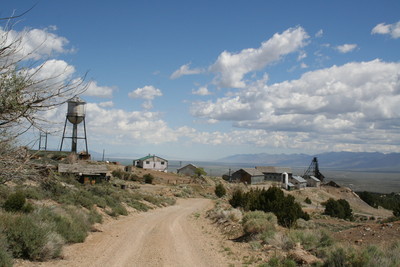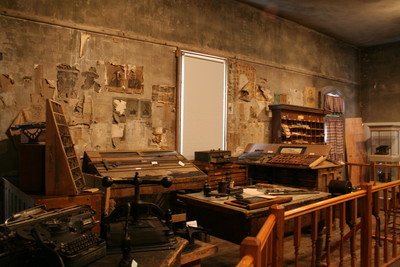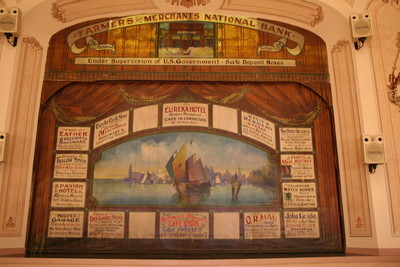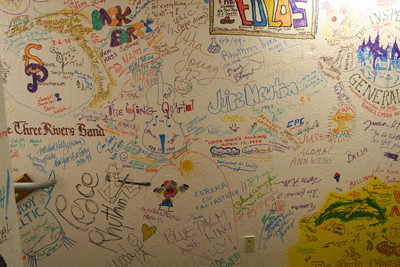Come Find the Past
"Eureka!" I exclaimed as we drove into the historic mining town along "The Loneliest Road in America."
It cost me an odd glance from Charlotte, my 11-year-old daughter and traveling companion. But driving into Eureka, one of Nevada's older and more interesting mining towns, had given me the excuse I had always wanted to shout the word that famously means "I have found it."
Of course, it wasn't I who actually found the first important American lead-silver deposit, creating Eureka back in 1864, but I was mighty pleased to finally arrive there. We had previously visited just about every other town in Central Nevada and spent many happy days exploring nearby Austin and Ely, but somehow missed Eureka.
Earlier this summer, Charlotte and I decided to fill that gap in our Nevada experience, and perhaps we saved the best for last.
Unlike many of Nevada's former mining centers, Eureka is no ghost town but a small, thriving community of about 500, which has managed to hold onto its past. By 1878, during peak mining production, more than 9,000 people lived here, making it the state's second largest city. Businesses included 100 saloons, a couple of dozen gambling houses, theaters, churches, hotels, an opera house and a post office.
To best appreciate its historic flavor we set out on a walking tour, starting at the Eureka Sentinel Museum, which also serves as the town's visitor center. The museum is housed in the two-story brick Eureka Sentinel newspaper building. The newspaper was published in this building from its construction, in 1879, until 1960.
On the main floor we toured the pressroom, which contains much of the original equipment: presses, typewriters, desks and cases that hold lead letters for creating print. Dozens of antique documents cover the walls, including handbills, advertising posters and almost any other ephemeral reading matter a small town might need. Like most newspapers of the day, the Sentinel was also in the job-printing business.
Upstairs we found a mining history room, complete with tools and richly engraved stock certificates. Other rooms contained old school memorabilia, home appliances, a parlor and barber shop, as well as artifacts from fraternal organizations and fire companies. There was even a restored gasoline pump. The price displayed on its face was 11 cents per gallon.
At the museum we picked up the walking-tour brochure and began that tour the moment we stepped outside. Most of the historic buildings are centered in a three-block area of downtown so even if you don't have a lot of time, you can easily visit many of the 48 stops listed. Most of the rest are still in range of a longer walk or a short drive.
Along the way we ran into Wally Cuchine, director of Eureka County facilities and economic development. Cuchine received the 2006 Distinguished Nevadan Award given by the Nevada System of Higher Education. He's a man of many interests, including a chief one: "I am an art collector and have one of the larger collections of Nevada art in this state."
His term "one of the larger" may be an understatement; he said he owns between 800 and 1,000 works of art. Through Sept. 30, Elko Museum will showcase 47 pieces from his collection.
"I was working in Ely as the room-tax administrator for White Pine County and came to Eureka April 1, 1993," said Cuchine.
Most people who live here now work in mining and agriculture or work for the school district, state or county. By 1880, Eureka had become a true American melting pot, with about 60 percent of the population foreign born. The Cornish, French, Germans and Irish made their way here to find work in mining and smelting. There were also many Chinese who generally worked as cooks, laundry workers, woodcutters, in the medical field and railroad construction. Italians were commonly found as charcoal burners, called carbonari.
The charcoal they made from local wood was essential to fuel the smelters that made mining profitable. But it also raped Eureka's landscape, which was formerly covered with pinyon pine and juniper. Virtually every tree was cut down in a 35-mile radius. And although the smelters were excellent for refining ore, the town, which was built in a canyon, suffered. Thick smoke, soot and black dust could not blow away, so the town quickly received the nickname "Pittsburgh of the West."
The trees have grown back and there is no air pollution now, so Eureka has become a pleasant place.
"It's quiet, peaceful and high in the mountains to be cool enough and it is a really quiet, nice place to live," Cuchine said. "We have deer, wild horses out and around, and pronghorn antelope."
Eureka lies at an elevation of 6,500 feet, so temperatures are perfect for outdoor activities through fall.
"There are lots of BLM roads that go out from Eureka in all directions for mountain biking and hiking," said Cuchine.
The narrow-gauge Eureka & Palisade Railroad was built in 1875 and made it possible to move ore north to the transcontinental Central Pacific, which hauled it to distant refineries that ran on fuels cheaper than charcoal. By 1891, the local smelters had all closed. But slag piles remain; you can see them as you enter town from either direction.
Between 1876 and 1880 a series of fires destroyed many of the town's buildings, but they were rebuilt. This time, fireproof materials, including thick brick walls and iron fire doors, as well as fire hydrants, were added for safety. Three buildings of that era turned out to be the highlights of our walking tour: the Eureka Sentinel building, the Eureka County Courthouse and the Eureka Opera House.
A faint path brought us on a shortcut over a tree-lined creek via a rickety wooden bridge, and here we found St. James Episcopal Church, the first church built in town. There are still services there. The building material was volcanic tuff quarried on Eureka's east side. Around to the right side of the church was a large bell, which was originally located in a tower farther up the hill. Charlotte lifted the attached handle as far as it would go and was about to release it when I stopped her. Doing so would have set the bell ringing for the entire town to hear.
We found other large bells around town, including one outside the museum, which was the original Presbyterian church bell, and two on either side of the courthouse entrance.
"The courthouse bells are old fire company bells," said Cuchine. "When a fire bell would ring each had a different tone, and (the corresponding) fire company would respond."
Our favorite stop was the Eureka Opera House, which now serves as a community, convention and cultural arts center. Built in 1880, the opera house was not only a venue for operas but also for masquerade balls, dances, concerts and movies throughout the years.
By the 1960s, the building was in bad shape. In 1990 the county acquired it, and spent $2.5 million over three years carefully restoring it. The transformation didn't go unnoticed, as it received the prestigious National Preservation Honor Award in 1994.
Upon entering the opera house, the first thing that catches your eye is the colorful 1924 stage curtain, painted with a scene of some far-away harbor, surrounded by advertisements for local businesses. This kind of drape is called an oleo; Eureka's burned in 1924 and the cost of replacing it was offset by selling advertising on it, a practice that was not unique to Eureka. The businesses represented on today's curtain are those who bought ads nearly 85 years ago. "
"The oleo curtain was put away into a wooden crate, set aside and after the renovation, rehung," Cuchine said. "The opera house was always a community center, but in 1940 the owners turned it into a movie theater by attaching seating."
The last movie played in 1958 and from then on the building was mostly unused and things started falling into disrepair. A ballot measure led to its restoration, and Cuchine arrived on the scene just as it was being finished.
From the beginning Cuchine wanted to bring in cultural events.
"I thought we should do presentations and we have done 12-18 cultural events a year for the last 14 years." The first performer he brought in singer Eddie Rabbitt on April 15, 1994.
Performers sign their names in colorful ink and marker on walls in the backstage stairwell and throughout the downstairs area that is used by performers and crew.
In one of the downstairs meeting rooms is a collection of Nevada art. There are 23 Great Basin artists represented, all of who did works involving Eureka in some way. In the same room Cuchine showed me the original film projectors, which have all been restored. One was used in the early days of silent movies, (the first silent movie was shown here in 1915). There are also a "talkies" and a carbon-arc spotlight.
On Sept. 26, the Missoula Children's Theater will present "Robinson Crusoe" and on Oct. 17, Richard Elloyan, singer, songwriter and cowboy poet will perform.
Old towns and ghosts go hand-in-hand, so Cuchine said he likes to think there are ghosts in the house.
"I think this entire town is filled with positive energy," he said. "Spirits enjoy living here and in this canyon."
Across the street is the Eureka County Courthouse, which first opened in 1879 and still remains the headquarters of county government. The building was restored about 20 years ago and is well worth a look inside. We first headed upstairs to the courtroom itself, where we found a pressed tin ceiling, chandeliers, wainscoting and an old potbelly stove. Charlotte took her place at the judge's Spanish cedar bench, which was probably against the rules.
There is also art in the courthouse's gallery hall. This 100-foot wall is used for touring art exhibits and starting this week will feature the Nevada Arts Council show "Out of Print," a collection of lithographs and intaglio relief prints, representing 25 of Utah's finest artists. The show will be on display through late October.
In 1986, Life Magazine named the 287-mile stretch of U.S. Highway 50 in Nevada, between Ely and Fernley, the "Loneliest Road in America" and recommended that drivers have survival skills just to travel it. The region's good-natured response was issuing "The Official Highway 50 Survival Guide," now available at a variety of stores, museums and other tourist stops along the road. Get it stamped at as many places you can while traveling this road, and you will be sent a certificate and pin certifying that you did, indeed, survive.
In my personal expectation, you will not merely survive, but enjoy it.
Contact Deborah Wall at deborabus@aol.com.
GETTING THERE Location: Eureka, 318 miles north of Las Vegas. Directions: From Las Vegas, take Interstate 15 north for 21 miles, exiting onto U.S. 93 north, the Great Basin Highway. Follow for 85 miles and go left, then take an immediate right onto Nevada Route 318. Follow this north for 111 miles. Turn right onto U.S. 6 and travel for 24 miles to Ely. Go west onto U.S. 50 and follow for about 77 miles to Eureka. Lodging: Best Western Eureka Inn, 251 N. Main Street. (775) 237-5247, bestwestern.com; Jackson House Hotel, 11 S. Main St., (775) 237-5577; Sundown Lodge, 60 N. Main St., (775) 237-5334; Ruby Hill Motel, 380 N. Main St., (775) 237-5339, www.eurekacounty.com. Restaurants: Eureka Cafe, serves lunch and dinner, (775) 237-7165. Owl Club, serves breakfast, lunch and dinner, (775) 237-5280. DJ's Drive in and Pizza, lunch and dinner, (775) 237-5356. All restaurants are located on Main Street. Eureka Opera House: Open Mondays-Fridays, 8 a.m.-5 p.m. Closed noon.-1 p.m. (775) 237-6006, www.co.eureka.nv.us. Eureka Sentinel Museum: 10 N. Monroe St. Open daily, May through October; open Tuesdays-Saturdays, November through April, 10 a.m.-6 p.m. (775) 237-5010. www.co.eureka.nv.us. Eureka County Courthouse: 10 S. Main St. Open Mondays-Fridays, 8 a.m.-5 p.m., closed holidays. (775) 237-5540. www.co.eureka.nv.us. Self-guided walking tour: A walking tour brochure and map are available at the Eureka Sentinel Museum or Eureka Opera House. Services: Eureka has a grocery store and gas station.




















